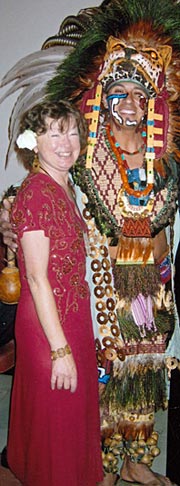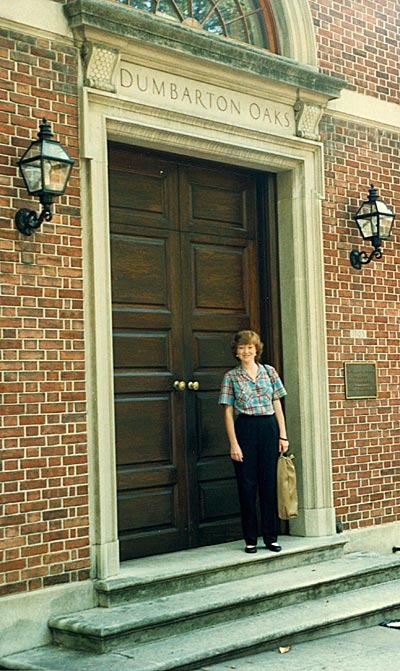

![]()
![]()
![]()
![]()
|
Mesoamerican studies lost an excellent scholar and outstanding person in the prime of life on Thursday, June 16, 2011. Virginia Fields was a pioneer in bridging academic scholarship and public education as the first curator of Precolumbian art at the Los Angeles County Museum of Art (LACMA). She transformed a tiny, new curatorial position into the world's most dynamic and intellectually exciting museum program in ancient Mesoamerican art and culture history.
Ginny's museum career began in 1984 at the Clarke Historical Museum in Eureka, California, where she curated their extensive collection of Native California baskets and wrote an in-depth publication, The Hover Collection of Kurok Baskets (1985). After short stints at Humboldt State University, Cal State-Northridge, and the University of California at Santa Barbara, where she taught Precolumbian and Native American art history, Ginny became the first curator of Precolumbian art at LACMA. She joined the museum as it was developing the ambitious exhibition "Mexico: Splendor of Thirty Centuries." During the next two decades, she created an impressive string of outstanding exhibitions and scholarly catalogs that explored new areas of the arts of the ancient Americas. These include Painting the Maya Universe: Royal Ceramics of the Classic Period (with Dorie Reents-Budet and Duke University; exhibition 1994-1995, catalog 1994), The Road to Aztlán: Art from a Mythic Homeland (with Victor Zamudio-Taylor; 2001-2002, 2001), Lords of Creation: The Origins of Sacred Maya Kingship (with Dorie Reents-Budet; 2004-2005, 2005), Olmec: Colossal Masterworks of Ancient Mexico (with Kathleen Berrin; 2010), and "Children of the Plumed Serpent: the Legacy of Quetzalcóatl in Ancient Mexico" (with Dr. John Pohl, UCLA; for 2012). Two of the catalogs (Painting the Maya Universe and Lords of Creation) won national awards from the College Art Association and the American Association of Museums for their academic and museographic quality, in spite of the academic prejudice against museum exhibition catalogs as lightweight stepchildren of serious scholarly publications. These awards were the direct result of Ginny's commitment to first rate academic research and public education. |
 (2006) | LACMA's new director Michael Goven, who arrived in 2006, provided the all-important institutional support to make the museum a world center for the study, appreciation, and public exploration of the art of the ancient cultures of Latin America and their importance to the United States and the world at large. Ginny's vision and power of persuasion is exemplified by Mr. Goven's allocation of significant museum resources to acquire and maintain the educational and academic website FAMSI (Foundation for the Advancement of Mesoamerican Studies / famsi.org). Without Ginny, this addition to LACMA's impressive educational resources would not have occurred, and her all-embracing efforts are a primary reason why LACMA has become a world center for Latin American art and culture history. Ginny increased the museum's holdings of ancient American art from c. 700 to more than 3,000 objects while abiding by national and international guidelines for the acquisition of cultural heritage. In recent years, she has been at the forefront of developing exhibitions and long-term loans in collaboration with sister institutions and governmental agencies in Latin America rather than building LACMA's collections exclusively from the international art market. This is the future of museums not only in the United States but worldwide, and Virginia Fields has been at the vanguard of this fundamental change in museum practices. |
|
The scholarly contributions of Virginia Fields often have taken second position to her widely known museum-based accomplishments although they are of equal merit. She received her B.A. (1978) and M.A. (1982) degrees from the Department of Anthropology, San Francisco State University, and a Ph.D. (1989) in Latin American Studies from The University of Texas at Austin. Among her myriad contributions is her discovery of the ideological foundation of Maya rulership. Ginny convincingly demonstrated that Maya rulers drew their right to rule based on the belief that they were like-in-kind to the Maize God, one of the principle gods of Creation according to ancient Maya religion. The long-held assumption was that Maya kings were "sun gods" who likened themselves to the power of the solar orb. Ginny proved this to be a faulty assertion based on uncritical comparisons to Aztec culture. The arguments were presented in her ground-breaking dissertation The Origins of Divine Kingship among the Lowland Classic Maya, which logically and concisely laid out the iconographic reasoning behind her refutation of the intellectual status quo and her identification of the Maize god jewel (the so-called "Jester god") as the primary symbolic emblem of Maya lords. Her treatise was supported by ethnohistoric and ethnographic data combined with art historical and archaeological data.
Ginny was among the first graduate students of renowned Maya scholar Dr. Linda Schele at the University of Texas. Her fellow students, including Constance Cortez, F. Kent Reilly, Dorie Reents-Budet, Andrea Stone, and Carolyn Tate, fondly remember Ginny's gentle and informed questions to Linda during graduate seminars: "But Linda, if we consider..." Although Linda might bristle at a wrinkle in her argument, she paid attention to Ginny's inquiring mind because she often isolated weak points in Linda's line of reasoning. Ginny published scholarly articles and proved to be a first-rate editor for the Pre-Columbian Art Research Institute's Mesa Redonda de Palenque series. She was honored recently by being appointed as a senior fellow in Precolumbian Studies at Dumbarton Oaks Research Library and Collections.
Virginia Fields is the epitome of scholarly integrity, congenial persona, and collaborative spirit. These were the foundation of Ginny's myriad projects that made each one a lasting contribution to Mesoamerican culture history and museography. Her commitment to inclusive education and elucidation for all was the driving force behind her herculean efforts to present the newest Mesoamerican discoveries for the world at large through exhibitions of the finest examples of human expression from the ancient Americas and publications of the highest quality. This is no mean feat in today's museum world. Virginia Fields will be sorely missed as we forge ahead in our pursuit of reconstructing culture history in the ancient Americas and discerning the effect of those cultures on anthropology as well as the general populace's knowledge of ancient history and its importance to our ever-changing, multi-cultural world. Virginia Fields is survived by family on the East Coast and her husband and closest friend Mr. David Miller, film maker and photographer, who shared Ginny's love of art and archaeology and who produced and directed the film for her exhibition "Lords of Creation." Ginny passed away in her sleep in Mexico City, with David at her side, from complications of living with diabetes since early childhood. She was working on her next exhibition project with partners in Mexico. Her friends and colleagues keep Ginny alive by following her lead in maintaining the highest level of scholarship while making available to a wide audience the discoveries of academic research. Ginny lives on in our efforts to find ever more ways for collaborative projects that benefit the greatest number of people — and so doing as she always did with grace and beauty. And we shall miss Ginny's heartfelt smile and easy laugh that she selflessly offered especially during those difficult moments which are a natural part of living a meaningful life. |
top - home
